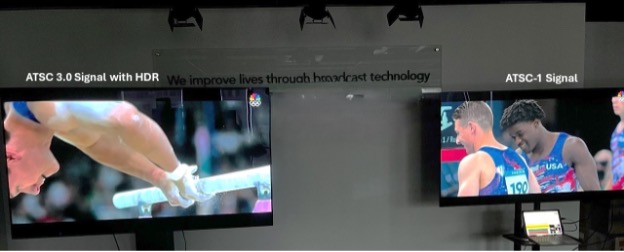One of the many benefits of ATSC 3.0 is the ability to render images in High Dynamic Range (HDR). HDR offers a wider range of contrast—brighter whites, blacker blacks and the capacity to render more details in the bright and dark areas of the picture. It’s a compelling feature and one that viewers can appreciate across the room, even on smaller sets. So what could be a better venue to show off this feature than the Summer Olympics!
NBC is offering advanced audio and video formats, including HDR, in select markets. In Washington, D.C., HDR (in the form of Dolby Vision) and advanced immersive audio (in the form of Dolby Atmos) were added to the NBC O&O station WRC on the ATSC 3.0 lighthouse hosted by WHUT just days before the Olympics Opening Ceremonies. The Olympics are, of course, a perennial favorite of TV viewers and more popular than ever: according to NBC, the first three days of the Paris games posted a 79% surge over the 2021 Tokyo Olympics to 34.5 million average viewers across all its platforms. We’re fortunate at NAB that in our NAB lab we have a healthy complement of TV sets for evaluation purposes, both ATSC-1 and ATSC 3.0, and we could watch the Olympics in ATSC-1 format from channel 4.1 as well as WRC’s ATSC 3.0 signal with HDR as shown in the picture below. It’s quite impressive.
This enhanced viewing experience is not limited to Washington, D.C., or the Olympics. According to recent statistics from Pearl TV, HDR is now available on at least one station in 67 of the 78 US markets that have launched ATSC 3.0 service, for a total of 124 station programs, including 56 NBC affiliated stations where you can watch the Olympics. And the number of HDR-enabled stations will no doubt continue to increase.

ATSC 3.0 and ATSC-1 Olympics images in the NAB Lab (note there is some delay in the ATSC 3.0 transmission).
Watching Celine Dion singing at the close of the Opening Ceremonies, I was reminded of watching her perform at a different Olympic Opening Ceremonies, in 1996 in Atlanta. But the video from Atlanta was still 4:3 aspect ratio, the picture resolution was only that which the NTSC 480-line standard definition system could muster, the sound was analog stereo and if you were watching over the air, you had to deal with all the usual analog reception impairments: echoes (ghosts), interference (double images) and noise (snow). In the summer of 1996, it would still be several months before the FCC officially adopted their digital television standard based on the ATSC transmission standard, and a 32 inch CRT television could easily weigh well over 100 pounds. Back to the current day, listening to Celine Dion’s crystal clear voice delivered via multichannel digital audio, noticing the glint of the sequins on her dress and the specular reflections of individual raindrops on the polished black top of the grand piano, it occurred to me that just like Celine Dion, terrestrial TV transmission really is having a big comeback too!

